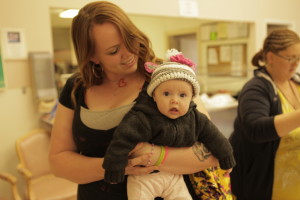On the front cover of the July/August issue of The Atlantic, a young woman with thick curly hair props her months-old son on her lap. The walls behind her are decorated with a farmyard scene. She could be anywhere. Her son's room. A daycare center. A church nursery.
In reality, she is in prison serving a sentence for a drug offense. Her son is with her. In fact, he has never been anywhere else.
BORN BEHIND BARS
Before she was released earlier this year, Alyssa Mayer was one of 13 women serving time at the prison nursery at Bedford Hills Correctional Facility (NY). Mayer gave birth to DeVanté two months after getting to prison and spent the rest of her sentence raising him behind bars. Aside from programs she would attend in the general population—GED classes, substance abuse treatment, etc.—Mayer would spend all of her time with DeVanté, nursing him, putting him to sleep, playing with him—all the typical things new mothers do with their children.
In the early 20th century, prison nurseries were a common thing, guided by the idea that “maternalism“ was a positive force to help wayward women reform. But by the mid-20th century, this idea had been replaced by the notion that “prison [was] no place for a child.“
However, since the early 1990s, there has been a resurgence of these prison nurseries, as research has leaned in the direction of the positive impact these arrangements have on the mother, the baby, and the community. Today, in addition to New York, nine other states have programs for mothers to keep their babies with them, until around 18-months typically.
BENEFITS OF PRISON NURSERIES
According to the article in The Atlantic, for the mother, having the opportunity to bond with one's child—as opposed to being forced to give birth and then relinquish the child immediately—often creates a desire to develop the skills needed to be a good parent. It also gives them time to dedicate just to their child, which, if they were on the outside, they might still be caught up in negative behaviors instead of paying attention to the child.
The opportunity to bond behind bars also reduces recidivism, according to numerous studies. In a Nebraska study, 50 percent of women who were forced to surrender custody of their child after birth returned to prison within 10 years. But of those who were able to spend time with their children in a prison nursery, only 16.8 percent returned to prison in that same time frame.
And research defends the benefits to the child as well (against earlier arguments that "prison is no place for a child"). Probably the most remarkable study in its defense was conducted in 1945 by the Austrian-American psychoanalyst René Spitz who examined two groups of children—those who were being raised by staff in a “foundling home“ (orphanage) and those who were being raised in the nursery of a penal institution for delinquent girls. At the end of his study, he found that among the children in the orphanage, few could walk, talk, or eat without assistance, even as old as 30 months. But for those in the penal institution, those as young as one year old could speak, move around without supervision, and demonstrate typical toddler curiosity.
Additionally, a paper published in 2010 by Mary Byrne found that 60 percent of children who had spent time with their mothers in prison showed signs of secure attachment, the same rate as that among children growing up in stable middle-class families.
To continue reading more about this fascinating phenomena of prison nurseries and to find out what happens to Mayer and DeVanté, check out “Prison Born” in The Atlantic.
